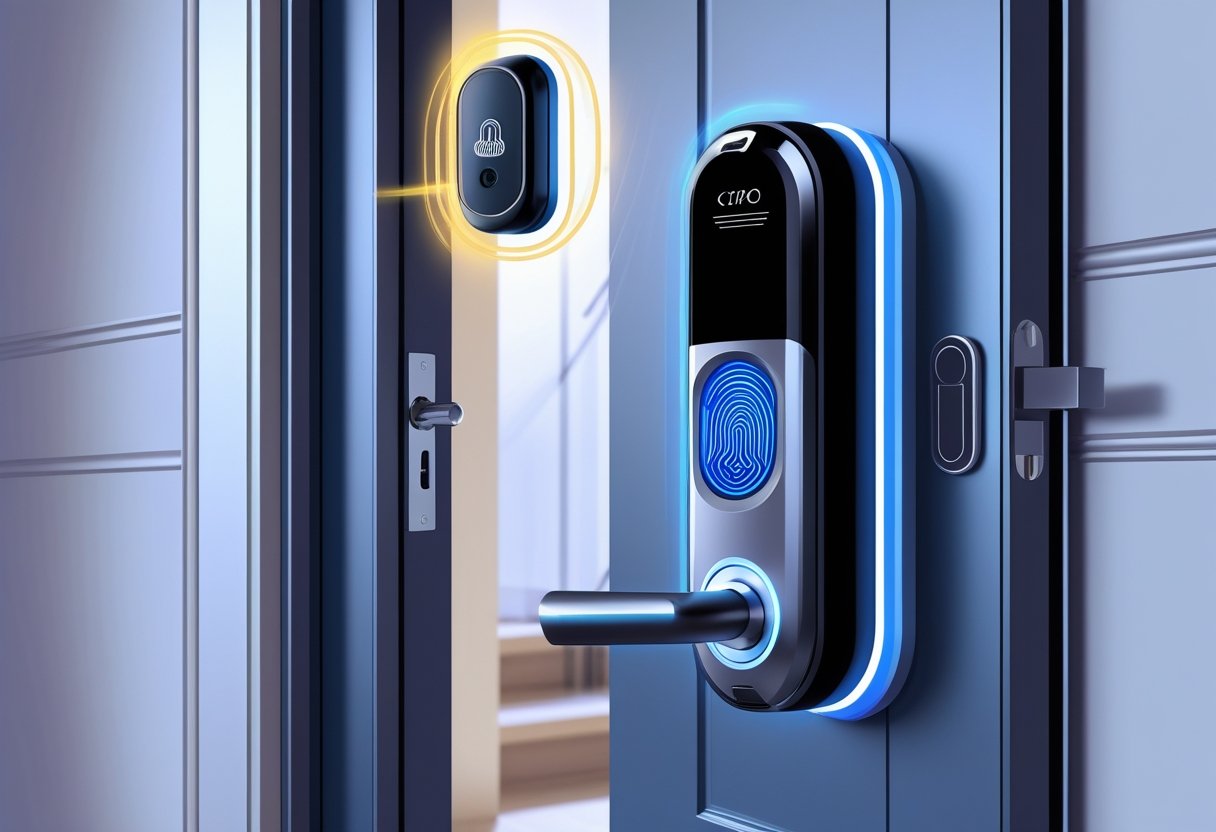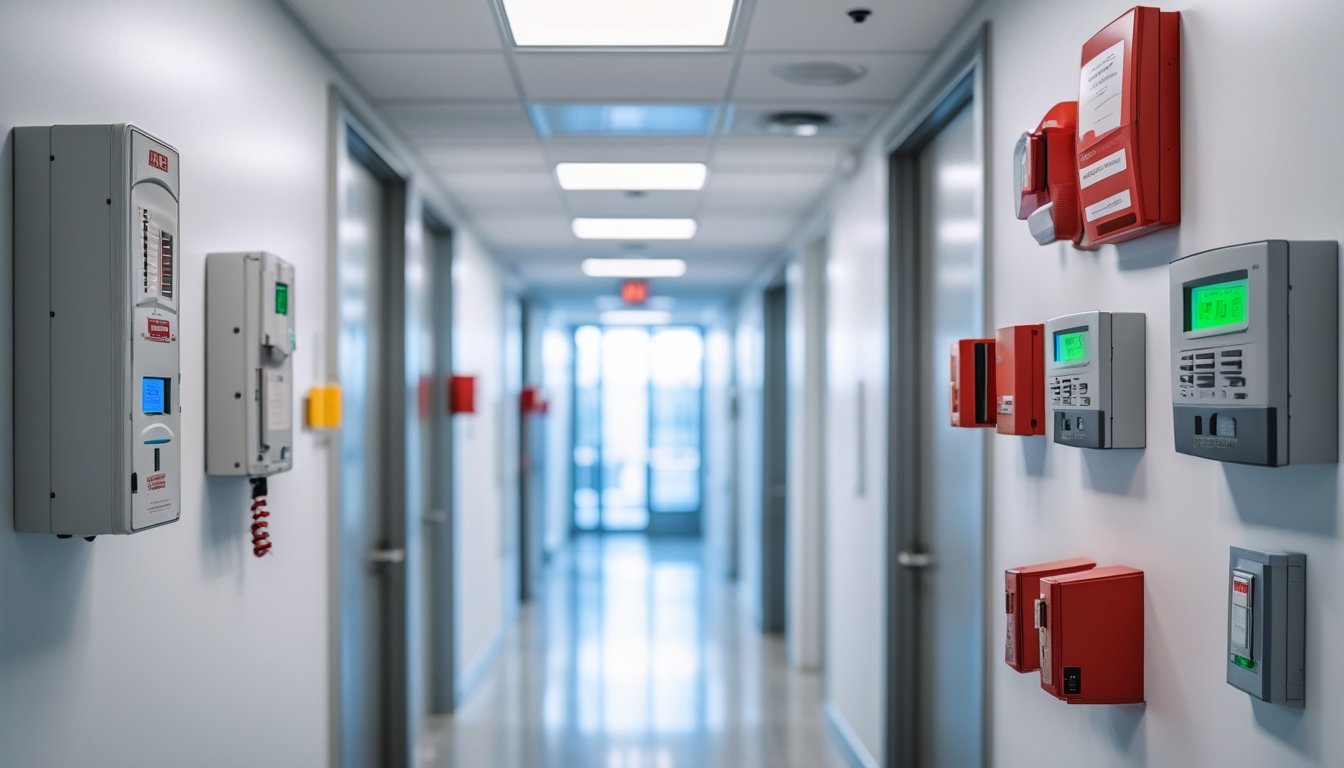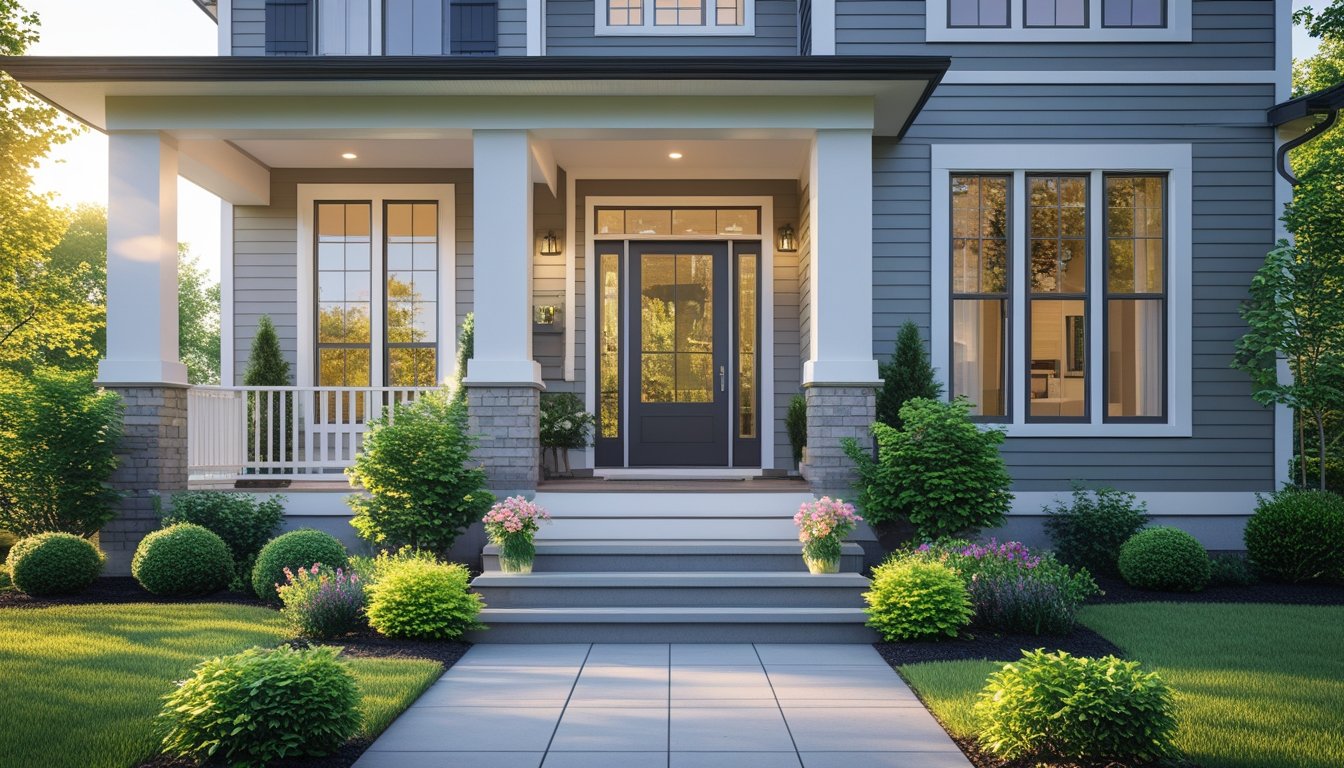Smart locks are becoming a key component of home security, offering convenience and enhanced access control. When integrated with fire alarm systems, these locks can significantly improve safety during emergencies. Knowing that your smart lock can release automatically in the event of a fire ensures that you and your loved ones can evacuate swiftly and safely.
Imagine a scenario where a fire breaks out, and your smart lock works in tandem with your fire alarm, securing exits and allowing emergency responders to access your home without delay. This integration not only protects your property but also promotes a quicker response during critical moments.
For residents in the greater Houston area, adopting smart locks with fire alarm integration is a proactive measure that can positively impact your emergency preparedness. By equipping your home with these technologies, you're taking a significant step towards safeguarding your family and enhancing the overall security of your living space.
Understanding Smart Locks With Fire Alarm Integration
Integrating smart locks with fire alarm systems enhances security and safety in your home. This section explores what smart locks are, how they connect with fire alarm systems, and the technology behind this integration.
What Are Smart Locks?
Smart locks are advanced locking mechanisms that allow you to secure your doors remotely or automatically. Unlike traditional locks, they often use connectivity options such as Wi-Fi, Bluetooth, or Z-Wave. This connectivity allows you to lock or unlock your doors via a smartphone app or smart home system.
Smart locks come with various features, including keyless entry and temporary access codes for guests. Some models can also notify you when the door is locked or unlocked. These features provide convenience while enhancing security. Additionally, many smart locks are compatible with existing security systems, making integration with fire alarms possible.
Overview of Fire Alarm System Connectivity
Fire alarm systems serve as critical safety devices in any home. In the event of a fire, these systems must activate alarms and notify residents. They can also be integrated with smart locks for enhanced functionality.
Typically, fire alarms can trigger smart locks to release automatically during emergencies. For example, if a fire alarm is activated, the smart lock will unlock to facilitate a safe evacuation. This integration can be achieved through protocols like Zigbee, Z-Wave, or Wi-Fi connectivity, ensuring seamless communication between devices. These connections are crucial for enabling quick responses in emergencies.
How Integration Works in Smart Home Technology
Smart home technology allows various devices to communicate and function together efficiently. Integration of smart locks with fire alarm systems typically involves a central hub or smart home system that manages communication.
When a fire alarm detects smoke or heat, it sends a signal through the hub, which relays instructions to the smart lock. This communication can happen via protocols like Z-Wave or Wi-Fi, allowing for real-time responses.
To ensure compatibility, check if your smart lock and fire alarm system support the same connection protocols. Proper installation and configuration are vital for this integration to function effectively. With this setup, you gain the peace of mind that your smart locks will respond to fire emergencies, facilitating a safe exit.
Key Benefits of Fire Alarm and Smart Lock Integration
Integrating fire alarm systems with smart locks provides a robust solution to enhance your home’s security and safety. This combination offers significant advantages, including improved fire safety measures, ease of access during emergencies, and increased convenience for daily use.
Enhanced Security for Home and Family
Integrating smart locks with fire alarm systems elevates your home security. By connecting these systems, you ensure that access is tightly controlled.
In the event of a fire alarm activation, smart locks can automatically unlock. This feature prevents panic during emergencies and allows for a fast evacuation.
Moreover, you can monitor and control your locks remotely through a smart home device app. This capability helps you keep an eye on who enters and exits your home, enhancing safety.
Fire Safety and Emergency Egress
Fire alarm systems are critical during emergencies. When paired with smart locks, they create an efficient egress path.
Automatic unlocking triggers when alarms sound, minimizing obstacles for evacuating family members. This immediate response not only saves time but also significantly increases safety.
It's essential to integrate your fire alarm into the locks to advance overall fire safety compliance. You can rest easier knowing your system provides a fail-safe mechanism.
Convenience and Automated Response
The integration of smart locks and fire alarms streamlines your home security workflow. Imagine having doors automatically unlock when an alarm is activated.
This convenience allows you to focus on evacuating without fumbling for keys or codes. Such automation brings peace of mind, knowing your home is both secure and ready for emergencies.
Additionally, controlling your locks remotely lets you grant access to others without being on-site. This feature fosters convenience while maintaining the integrity of your home security.
Combining these systems ensures a smoother, more efficient response to emergencies while enhancing your everyday security.
Core Features and Functionality
Smart locks equipped with fire alarm integration provide essential security features tailored to your needs. These devices enhance convenience and safety through advanced capabilities like remote access, voice control, and reliable battery backup. Understanding these core features empowers you to make informed decisions about securing your premises.
Remote Access and Access Management
With smart locks, you can manage your door remotely, providing significant advantages for security and convenience. Using a smartphone app, you can lock or unlock your door from anywhere, which is crucial during emergencies.
You can grant access to trusted individuals without needing physical keys. For instance, you can create temporary access codes for visitors or service personnel, eliminating the need for you to be on-site. This flexibility in access management is particularly valuable for those in the greater Houston area who require quick and easy entry solutions.
Access Control and Custom Access Codes
Smart locks offer robust access control features, allowing you to tailor who can enter your home. You can create custom access codes for different individuals, aiding in tracking who has accessed your property and when.
This feature is beneficial for families with multiple members or when you want to provide limited-time access to guests. For example, you can set a code that only works during specific hours, enhancing security during off-peak times.
Voice Control and Integration With Alexa
For added convenience, many smart locks integrate seamlessly with voice-activated systems like Alexa. This allows you to lock or unlock your door using simple voice commands, making entry easier when your hands are full or when you're preoccupied.
Integrating smart locks with your Alexa-enabled devices allows for comprehensive smart home management. You can ask Alexa to confirm the lock status or even integrate it with other smart devices for a holistic security approach.
Battery Backup and Reliability
Power outages can impact traditional locking mechanisms, but smart locks often come with battery backup features to ensure continuous functionality. This reliability is vital for users concerned about their security during outages or emergencies.
The battery life in these devices typically ranges from several months to a year, depending on usage. Many models provide alerts when battery levels are low, allowing you to replace them before they run out. This ensures that your home remains secure, particularly in high-stakes situations like fire alarms.
Integration Methods and Compatibility
When considering smart locks with fire alarm integration, it’s essential to focus on the protocols used for communication, compatible devices, and the central hubs that enable seamless security system integration. Understanding these aspects will enhance your ability to select and set up the right solution for your needs.
Protocols: Z-Wave, Zigbee, Wi-Fi, and Bluetooth
Smart locks typically operate on several communication protocols. Z-Wave is popular for its low power consumption and reliable mesh networking. It allows devices to communicate over longer distances without needing a direct line of sight.
Zigbee functions similarly but is designed for low-data-rate applications, making it suitable for home automation devices. Wi-Fi enables high-bandwidth communication, great for streaming data but may drain battery life faster.
Bluetooth allows for short-range communication and is ideal for mobile access. Depending on your home setup, you might prefer one protocol over another to ensure optimal connectivity and performance.
Compatible Smart Locks and Devices
Compatibility is crucial when integrating smart locks with fire alarm systems. Popular smart locks—like the August Smart Lock and Schlage Encode—support various protocols, making them versatile choices.
Before purchasing, check the compatibility list of your chosen smart lock to ensure it works with your fire alarm system. Manufacturers often provide resources on their websites detailing which devices and systems can be integrated, helping you avoid any mismatch.
Additionally, many security companies provide a range of compatible smart devices, allowing for comprehensive home security solutions. This can include cameras, alarms, and sensors that enhance your overall safety.
Central Hubs and Security System Integration
Central hubs play a pivotal role in integrating your smart locks with fire alarm systems. Devices like SmartThings or Wink allow for easy control of multiple devices from a single interface. They help consolidate your smart devices, enabling unified monitoring and management.
Security systems that incorporate access control, video surveillance, and fire alarms can work more efficiently when connected through a central hub. Ensure your hub supports the necessary protocols, whether it's Z-Wave, Zigbee, or Wi-Fi.
Utilizing a central hub can facilitate automated responses during emergencies, such as unlocking doors for emergency services. Choosing the right hub simplifies your integration process and ensures your smart locks and fire alarms work in harmony.
Considerations for Installation and Monitoring
When integrating smart locks with fire alarm systems, several considerations are essential for effective installation and monitoring. Proper setup ensures security and safety, while ongoing monitoring allows for quick responses in emergencies.
Home Automation Setup and Configuration
Establishing your smart lock within a home automation system is crucial for seamless operation. You should ensure compatibility with your existing setup, whether it's through platforms like Z-Wave or Zigbee.
During installation, carefully follow the manufacturer's guidelines. This includes connecting the lock to your fire alarm system, enabling automatic unlocking during emergencies. You can also create unique user codes for family members or trusted visitors, which can be monitored or adjusted via your app.
It's important to regularly check and update the firmware of both the lock and the fire alarm system. This ensures optimal performance and security.
Mobile App Control and Monitoring
Utilizing a mobile app to control your smart lock is highly beneficial. The app allows you to monitor the lock status, receive notifications about lock activity, and manage access permissions remotely.
You can also adjust settings from your smartphone, ensuring that you can respond quickly to any issues. For example, if a fire alarm triggers, your app should notify you that the door has automatically unlocked for safe evacuation.
Check that your mobile app integrates seamlessly with other home automation devices, allowing for comprehensive control under one interface. Prioritize security features like two-factor authentication to protect your access.
Integration With Security Cameras and Motion Detectors
Integrating smart locks with security cameras and motion detectors enhances overall home security and monitoring. When motion is detected near an entrance, your security cameras can provide a real-time video feed to identify potential threats.
With proper configuration, you can set your cameras to alert you if unusual activity occurs near the door. This feature works hand-in-hand with your smart lock, allowing you to lock or unlock the door remotely should a situation arise.
Consider setting up automated responses in your system. For instance, if the fire alarm activates, the smart lock should release immediately, while your cameras can document the situation. This integration not only provides safety but also peace of mind.
Choosing the Right Solution for Your Home
Selecting the right smart lock solution for your home, especially with fire alarm integration, requires careful consideration. You'll want to focus on compatibility, the available integration options, and effective access management practices that keep your home secure.
Factors to Consider for Compatibility and Performance
When choosing a smart lock, ensure it is compatible with your home’s existing fire alarm system. Not all smart locks can integrate seamlessly, so check the specifications from manufacturers. Look for locks that support protocols like Z-Wave or Zigbee, which often enhance compatibility.
Evaluate the lock's performance by considering its response time in emergencies. A smart lock that can communicate with your fire alarm promptly is essential for safety. Also, think about the power source; battery-operated locks may require regular checks or replacements to maintain functionality.
Popular Smart Lock Integration Options
In the Houston area, several smart lock brands offer integration with fire alarm systems. For instance, August Smart Lock provides easy connectivity with various alarm systems. Kwikset and Schlage also offer popular models with robust integration features.
Magnetic locks are another option; they provide strong security and can be integrated with fire alarm systems for automatic unlocking during emergencies. Choose a model that ensures quick disengagement, which can be critical during a fire.
Best Practices for Access Management and Upkeep
Managing access to your smart lock is crucial for maintaining security. Use a secure app that allows you to control access remotely. Set specific access times for each user and adjust permissions as needed.
Regular maintenance checks will ensure that your smart lock and fire alarm integrations are functioning correctly. Schedule device updates to enhance security features and fix any potential vulnerabilities.
In Houston, you should also consider who has access to your home at different times to prevent unauthorized entry. Using a system that logs entries helps track usage and identify any irregularities.
Frequently Asked Questions
Understanding smart locks with fire alarm integration can help enhance your home's security. Below, you will find specific answers to common queries regarding smart locks and their compatibility with fire alarm systems.
What are the top-rated smart locks that offer fire alarm integration?
Popular options include the August Smart Lock and Schlage Encode. These smart locks are known for their robust security features and compatibility with various fire alarm systems. They allow for easy integration, ensuring that your exit routes remain secure during emergencies.
Do Schlage smart locks provide compatibility with interconnected fire alarm systems?
Yes, Schlage smart locks can be integrated with interconnected fire alarm systems. This compatibility ensures that when a fire alarm is triggered, the locks can automatically unlock, allowing for safe and efficient evacuation.
How does fire alarm integration with smart locks enhance home security?
Fire alarm integration allows smart locks to work in tandem with your existing safety systems. When a fire is detected, the locks unlock, facilitating quick exits. This seamless communication enhances your overall safety by ensuring that barriers do not impede escape in emergencies.
Which smart lock models are compliant with fire safety regulations?
Models like the Yale Assure and the Kwikset SmartCode series meet various fire safety regulations. These locks are designed to function correctly during a fire emergency, ensuring compliance with local codes and regulations that prioritize safety.
Can Yale smart locks be connected to fire alarm systems for enhanced safety?
Yes, Yale smart locks can be connected to fire alarm systems. This connection allows for the automatic release of locks when a fire is detected, thereby promoting safer evacuation routes. This feature is crucial for ensuring that all occupants can exit quickly.
What are the potential drawbacks of using smart locks with fire alarm integration?
One potential drawback is the reliance on power. If there is a power failure, some smart locks may not function as intended. Additionally, compatibility with specific fire alarm systems can vary, so ensuring that your devices are fully integrated is essential for optimal performance.
.svg)



.svg)


.svg)



